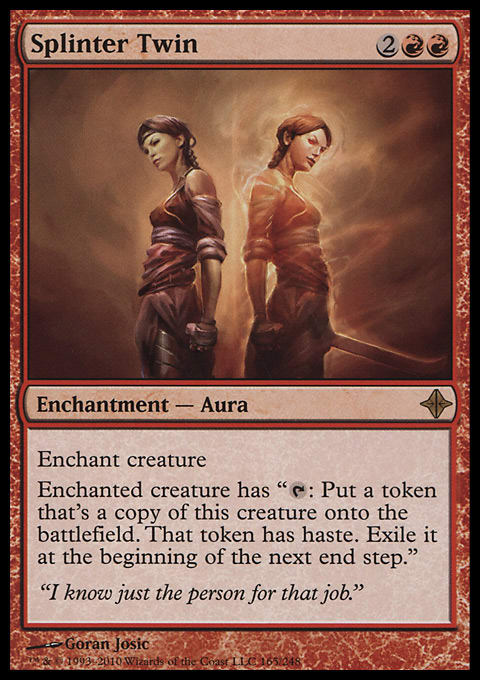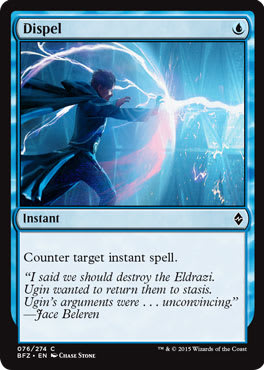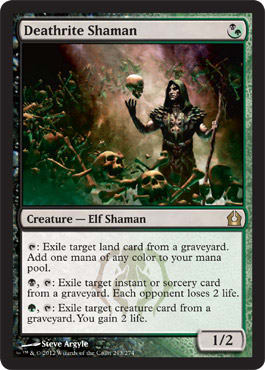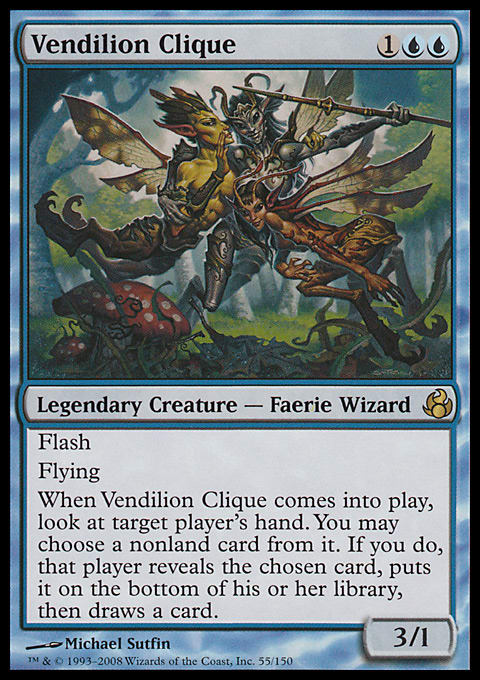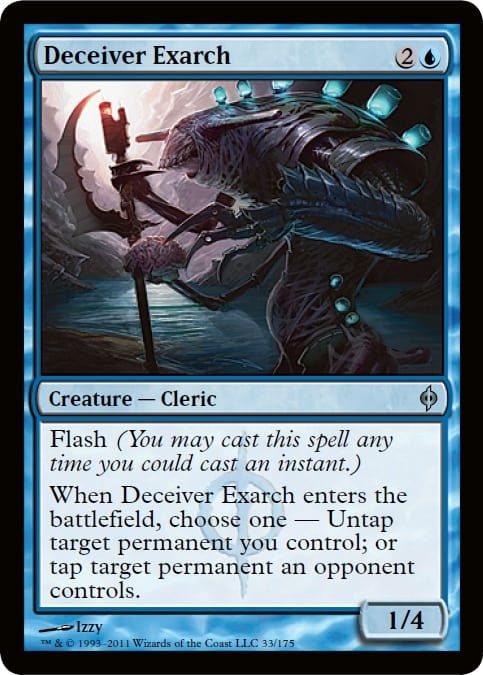Hey there! I’ve been writing about tournaments and preparation a lot lately. As I haven’t yet had time to get into the new Standard, I thought it might be a good idea to write a good old primer about the deck I played at Pro Tour: Return to Ravnica: Splinter Twin.
Most of the big Modern events have already been, but for those of you looking to pick up something interesting for your local tournaments or for Magic Online, this article will present one good choice. Other than these smaller tournaments, there is still Grand Prix: Toronto on the horizon, so there is some high-level Modern play to look forward to. I’ll start by introducing the idea behind the deck and follow that up with the current decklist and a discussion of the card choices. I’ll finish off with a rough sideboarding guide and some tips on playing the deck.
Inifinity Faeries
Many of you might be familiar with how the Twin deck works, but for those who are less familiar with the concept, here is how things work. The first order of business is to play either a Pestermite or a Deceiver Exarch, preferably at the end of your opponents turn to avoid sorcery-speed removal. The next thing you want to do is to either enchant the creature with Splinter Twin or play a Kiki-Jiki, Mirror Breaker and make a copy of the creature. When the copy enters the battlefield, you generate a trigger, which you can use to either untap Kiki-Jiki, Mirror Breaker or the creature enchanted with Splinter Twin. Now you are back where you started, and you can repeat the process as many times as you like and kill your opponent with an army of hasty tokens.
Twin is what is referred to as a two-card combo deck. What this means is that two specific cards are required to win. This particular combo has a bit of redundancy, with two pieces to fill the role of Card A and two pieces to fill the role of Card B. This is fundamentally different than many of the other combo decks in Modern—such as storm, Eggs, or infect—which are more of engine decks, wherein you need a certain number of different cards to win the game. Both of these two types have their own strengths and weaknesses. The main thing I like about two-card combo decks is that you know you are going to win when you assemble the combo, unlike storm or Eggs, for which you can fail to win if you draw a certain sequence of cards. I should know; it’s happened to me on a Pro Tour Sunday.
This decklist originates from a list I received from Matti Kuisma, so many thanks to him for the original idea. Without further ado, here is the current decklist I’m recommending.
"U/R Twin"
- Creatures (12)
- 3 Pestermite
- 4 Deceiver Exarch
- 2 Spellskite
- 3 Kiki-Jiki, Mirror Breaker
- Spells (25)
- 1 Mizzium Skin
- 2 Spell Snare
- 3 Remand
- 4 Dispel
- 1 Mizzium Mortars
- 2 Gitaxian Probe
- 4 Serum Visions
- 4 Sleight of Hand
- 4 Splinter Twin
- Lands (23)
- 1 Mountain
- 5 Island
- 1 Breeding Pool
- 1 Stomping Ground
- 3 Steam Vents
- 4 Misty Rainforest
- 4 Scalding Tarn
- 4 Sulfur Falls
- Sideboard (15)
- 2 Blood Moon
- 2 Sowing Salt
- 2 Grafdigger's Cage
- 2 Ancient Grudge
- 2 Vendilion Clique
- 2 Grim Lavamancer
- 1 Flame Slash
- 1 Wurmcoil Engine
- 1 Mizzium Skin
As you might notice if you have read my previous articles, the list is practically the same as before. The only change I’ve made was to cut a Steam Vents for an additional Island in order to make Blood Moon slightly better. Here is a quick rundown of the card choices in the main deck.
Combo pieces – I feel seven-plus seven is a good number. Deceiver Exarch is much better than Pestermite, and the same is true for Splinter Twin versus Kiki-Jiki, Mirror Breaker. Some lists play only two of the legendary Goblin, but as you want to draw these pieces early on, I feel you want the seventh red combo piece.
Two Spellskite – some lists have gone down to zero Spellskites, but I think it’s worthy of the inclusion. It serves as a roadblock against many of the aggressive decks, and it soaks up the first removal spell aimed at your combo creature. With the prevalence of Abrupt Decay in Jund, I feels that Spellskite gets to do some serious work.
Four Serum Visions, four Sleight of Hand, and two Gitaxian Probe – You have to play some cantrips to find the combo pieces, and these are pretty much the only ones we have to work with. Serum Visions in particular is a terrible card in my opinion, but it’s something this deck sorely needs. Gitaxian Probe is not as good here as in storm, for example, but receiving that free information can be super-relevant when playing against decks such as R/W/U Delver or W/U midrange.
Four Dispel – This is the best counterspell for this deck in my opinion. Path to Exile is quite popular, and Dispel is the best tool to avoid it. Dispel also shines in the combo matchups, wherein is can just wreck the opponent if played at the right moment. I played against Eggs at Pro Tour: Return to Ravnica, and it felt as though all I needed to do was to draw one Dispel to win the game.
Three Remand and two Spell Snare – This split was something I just decided on before the Pro Tour, and it worked out well in my opinion. The first Remand is always awesome, but multiple copies can sometimes clog up your hand, so that was the main reason to cut one. Spell Snare acts in the same role as Lightning Bolt or other removal sometimes did, as it helps buy you time. Countering Jund’s turn-two Tarmogoyf or Dark Confidant is a very powerful play with this deck, as it gives you so much time.
One Mizzium Skin – This is a card that we came up with only a couple of days before the Pro Tour, and I’m happy we did. It serves as an additional Dispel, and it’s often better. The uses are more limited, so that is why I decided to play the fourth Dispel over the second Mizzium Skin in the main. Mizzium Skin is at its best against some of the cards that otherwise give you headaches, such as Combust and Abrupt Decay. I’m happy this deck doesn’t need to splash green just for Vines of Vastwood anymore.
One Mizzium Mortars – Boom goes the dynamite! In all seriousness, though, we wanted to play one main-decked removal spell that kills both Linvala, Keeper of Silence and opposing Spellskites. We initially had Flame Slash, as it’s a super-efficient removal spell, something this deck really wants. However, I came up with Mizzium Mortars as a way of combating the Soul Sisters deck that is somewhat of a nightmare matchup with the current list. Mizzium Mortars is slightly worse than Flame Slash in most situations, but against Soul Sisters, the mere existence of the card in your deck turns an otherwise terrible matchup into a good one. If the Soul Sisters deck even resolves two Soul Warden–style cards, you can’t win with the normal combo. However, if you assemble Pestermite and either of the red combo pieces, you can create an arbitrarily large number of flying blockers. This then helps you stay alive until you can find the Mizzium Mortars, kill all those pesky Soul Wardens, and finally kill your opponent. I’d say that’s a pretty well-deserved spot for just one card in the main deck.
Sideboarding
I have to say that I haven’t had much time to play Modern after I returned from the U.S., so the sideboard might need a bit of tweaking. The fact that almost all Jund lists play Deathrite Shaman and more fetch lands than before means that Blood Moon has lost some of the power it used to have. I decided to cut one Blood Moon and one Flame Slash to make room for a couple of Grim Lavamancers in the sideboard, as they are good in many matchups, Jund included. Instead of going through each sideboard card and discussing it in general, I’ll instead go through different matchups so you can see when the different cards come in.
Jund:
+2 Blood Moon
+1 Mizzium Skin
+1 Flame Slash
−4 Dispel
−3 Remand
Dispel is not all that great here, but with Jund decks starting to play Rakdos Charm, it might be necessary to leave a few in. I feel that Blood Moon is still good here even though I stated it has become a bit worse. The Grim Lavamancers and removal spells can help you pick off any Deathrite Shamans to deny your opponent the black and green mana should you draw the Blood Moon. This is quite a tricky matchup, as Jund has removal, discard, and a fairly solid clock. However, Jund players have to be really careful with how they play their cards, as tapping out might mean they are just dead. You have to try to take advantage of this, sculpting a game plan in which you resolve your combo with one or two pieces of disruption at an opportune time. I’m not going to say this will be a walk in the park, but luckily, it seems Jund decks are only playing roughly five discard spells, which makes your life a lot easier than when they played seven.
Affinity (no, it’s not Robots):
+1 Flame Slash
−3 Remand
Remand is really slow here, and Gitaxian Probe is not the best either when you are trying to conserve your life points. If the opponent is playing the version without Galvanic Blast, life becomes so much easier for you. If you suspect your opponent might have Combust, it might be a good idea to bring in the second Mizzium Skin. This is in general a very good matchup, as affinity decks have a hard time racing you if you have a fast combo since the trigger from Deceiver Exarch or Pestermite is often close to a Time Walk. After sideboarding, things become more grindy, but you should be able to handle that fine and play around the disruption affinity might have. The most common form of disruption is Thoughtseize, countermagic, or some form of removal, but you might also see Torpor Orb. Luckily, you are already bringing in some artifact removal to avoid that particular hate card.
As a side note, we had a hard time deciding between Ancient Grudge, Shatterstorm, and Vandalblast as our artifact removal of choice. We ended up with Ancient Grudge as it was the most flexible in other matchups. Twin is also a deck that aims to kill on turn four, so playing a more expensive sweeper didn’t really fit into the game plan. You would rather just stop the early pressure with a removal spell on turn two and then try to just kill the opponent quickly. In many other decks, the sweepers are much better, as you are building a board presence and winning in a more traditional way. As you see with this example, it’s really important thinking through all the sideboard options from the perspective of your own game plan and not just which is the most powerful card.
Storm and Eggs:
+1 Mizzium Skin
−2 Spellskite
Kiki-Jiki, Mirror Breaker can be a bit of a liability as a 5-mana spell, so I feel that you can easily take one out. I like to preemptively side in one Ancient Grudge to take care of potential Torpor Orbs. Against Eggs, I would probably bring in the other Ancient Grudge as well since it has its uses. These two matchups are really good, as you have more disruption than the opponent does, and you can kill him out of nowhere, so he doesn’t have the luxury of having many turns to sculpt that perfect hand. That said, this is still a tricky matchup to play, as you have to be careful with your mana so that you don’t accidentally tap out early and die with countermagic in your hand.
W/U midrange:
+1 Mizzium Skin
This is a tough matchup, not necessarily because it’s difficult to win, but rather because playing optimally is very difficult. The fact that the opponent has both countermagic and removal makes it tough to know when to go for it. The opponent will also typically have somewhere between six and eight flash creatures, meaning he can afford not to tap out during his own turn and still put on pressure. However, not all is lost, as the deck has quite a lot of dead cards. Kitchen Finks and Geist of Saint Traft are both cards that are very risky for the W/U player to play, and Spell Snare doesn’t counter any of your relevant spells. This leaves you mostly playing around Path to Exile, Dismember, Mana Leak, and Cryptic Command. This is a much more manageable task than playing around almost all of your opponent’s deck. Timing is crucial here, as you can sometimes catch your opponent unprepared in the midgame.
Scapeshift:
+2 Blood Moon
+1 Mizzium Skin
−2 Spellskite
This depends a lot on the Scapeshift version in question, but I’m assuming a pretty standard R/U/G Scapeshift. If the player is playing a version with more than two Valakut, the Molten Pinnacles, it might be worth bringing in Sowing Salt and try to just take them all out. This plan mostly applies to the versions with Prismatic Omen, as those decks usually play the full four Valakut, the Molten Pinnacle. This matchup should be fairly easy unless the opponent has a ton of hate.
R/G Tron:
+2 Blood Moon
+2 Sowing Salt
+1 Mizzium Skin
−4 Dispel
−2 Spellskite
−2 Spell Snare
This is the main matchup for the Sowing Salts to come in. They act as kind of an additional combo piece, as if you are able to play one of those, you are quite sure to win. You earn a massive amount of extra time in which to set up your combo or just randomly kill with Vendilion Clique beatdown. I’m assuming the opponent’s hate consists of mainly Combust, Torpor Orb, Oblivion Stone, and Nature's Claim, so the Dispels and Spellskites don’t really do much. Blood Moon is actually not very good in this matchup, but it’s still good enough that I would bring them in, as the cards you are taking out are not that great.
I feel that segment covers most of the popular decks in Modern at the moment. I’m sure there are many decks I’ve forgotten, so feel free to ask me about additional matchups in the comments section. Sideboarding guides should never be taken as absolute truth, since the composition of your opponent’s deck should really dictate how you sideboard. However, this guide should at least give you a rough idea of what you are trying to accomplish in each of these matchups.
And as promised, here are some general pointers on playing the deck.
- If you have time, wait to assemble a hand that can win through one or two pieces of disruption. A common play is just to wait an extra turn and play a Deceiver Exarch with
 up for Dispel, forcing your opponent to have two answers in order to not lose.
up for Dispel, forcing your opponent to have two answers in order to not lose. - Don’t forgot that 7 mana in play with Kiki-Jiki, Mirror Breaker and one of the blue combo pieces in hand means you can combo off (play the blue combo piece, untap a land, play Kiki-Jiki). I think I made this blunder at the Pro Tour, but I’m not totally certain if I had six or seven lands at that point.
- Try to think about what hate cards your opponent might have, and then plan for each scenario separately. By coming up with several game plans early on in the game, you can easily switch between separate plans once you narrow down what the opponent has from the way he plays. This might sound simple, but in practice, it can be very hard. Coming up with even one game plan many turns in advance can be challenging, let alone having to construct several simultaneously.
- If you are playing on Magic Online, the clock can often be your enemy if your opponent makes you go through with the combo. This is especially true if the opponent has something like Soul Warden in play that makes going through a single iteration take even longer. Try to play fast with the deck so that you don’t time out. This has not really been a problem for me so far, so don’t worry too much about it.
Signing Off
I hope you have found this article helpful, either as a player new to this strategy or as a veteran trying to get new insights on a familiar subject. A nice thing about Twin is that the deck is quite inexpensive to put together on Magic Online, with the mana base being the most expensive part of the deck. I don’t yet know what I’m writing about next week, so if you have any ideas or suggestions, be sure to chime in either through Twitter or the comments section below.
Thanks for reading,
Max
@thebloom_ on Twitter
Maxx on Magic Online
You can find my music on: http://soundcloud.com/bloomlive














